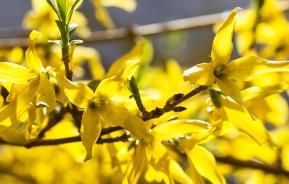Begin with bulbs
While there’s still a bit of warmth in the soil in autumn, it’s ideal to get planting bulbs like daffodils, hyacinths, crocus, tulips, and snowdrops. For most bulbs, pick a sunny spot with well-drained soil and using a bulb-planter or trowel, dig a hole that is approximately three times the length of the bulb that you are planting. For instance, if the bulb is 2 inches in length, the hole will need to be 6 inches deep.
Otherwise, they will be planted too shallow and squirrels will be able to dig and get to them. After digging the hole, add a layer of bulb fibre compost which is perfect for outdoor and indoor use so it can be used for growing in containers in your home or garden too. The innovative bulb fibre formula encourages fast root growth and even helps bulbs to flower again next season!

When planting, I use the lightbulb technique, ensuring that the tip is pointing upwards and the roots downwards. The lightbulb technique involves pushing and twisting the bulb into place just like how you would fit a lightbulb. It ensures that the bulb is snug in place and there’s no pockets of air underneath where water can gather and lead to the bulb rotting.
Once the bulb is in place, the compost and soil can be put back into the hole to cover it up. Be sure to add a plant label to the area to remember which bulbs you planted where.
When growing bulbs in containers, they don’t have to be planted as deeply as those in beds and borders and they can also be planted closer together for a bigger and more beautiful impact of clustered blooms.
Vibrant varieties
With the autumn leaves falling, us gardeners like to plan ahead and dream of those displays in spring. So, depending on your desired colour scheme in the garden, you may want some dark and dramatic colour which you will get from the variety of tulip called ‘Black Parrot’, their deeply coloured flowers with frilled margins look almost gothic.
Alternatively, for a pretty, pink pick, mahogany fawn lilies have dainty, nodding flowers that bloom on very thin stems. They will look right at home in a rock garden in a partially shaded spot. Or, if you have a wildlife garden and want to invite the pollinators in, Muscari azureum (azure grape hyacinth) may look delicate but they are very hardy. What’s more is these are a great low maintenance choice that will suit many garden styles from informal cottage to city courtyards.
For a bulb to naturalise in your lawn for a brilliant show, Narcissus (daffodils) are perfect for this. To mimic how they would appear in the wild it’s best to position them randomly, so they look natural rather than too uniform. ‘Jack Snipe’ is a hardy, spring-flowering perennial that has white flowers with yellow coronas that will brighten up your lawn next growing season.
Take care
Bulbs are easy to grow because they don’t demand much. They are particularly low maintenance when grown in the ground, and those that are container grown will appreciate a little extra water and food.
Whilst they are growing, they will need water to help encourage further growth and once the leaves have died down it’s important to water them for the following six weeks. After this time, they become dormant so won’t need any more watering.
Also, as soon as shoots appear, feeding the bulbs every week or two with a fertiliser that’s high in potassium such as tomato food will help encourage blooms. The feed simply needs to be diluted with water and applied to the base of the plant, taking care to avoid getting it on the foliage.

On the other hand, bulbs in containers may need more watering so the soil doesn’t try out. When the soil is slightly damp, rewater to keep it moist but not wet. Like bulbs planted in the ground, feed should be applied when shoots appear, continuing to feed until the foliage yellows and dies back. When the delightful displays are over, deadhead the spent flowers and cut down to the base of the stalk.
Autumn is a great time to plan your displays and plant your bulbs using my top tips for a successful spring. For such little work, your borders can be bursting with blooms, what’s not to love?








